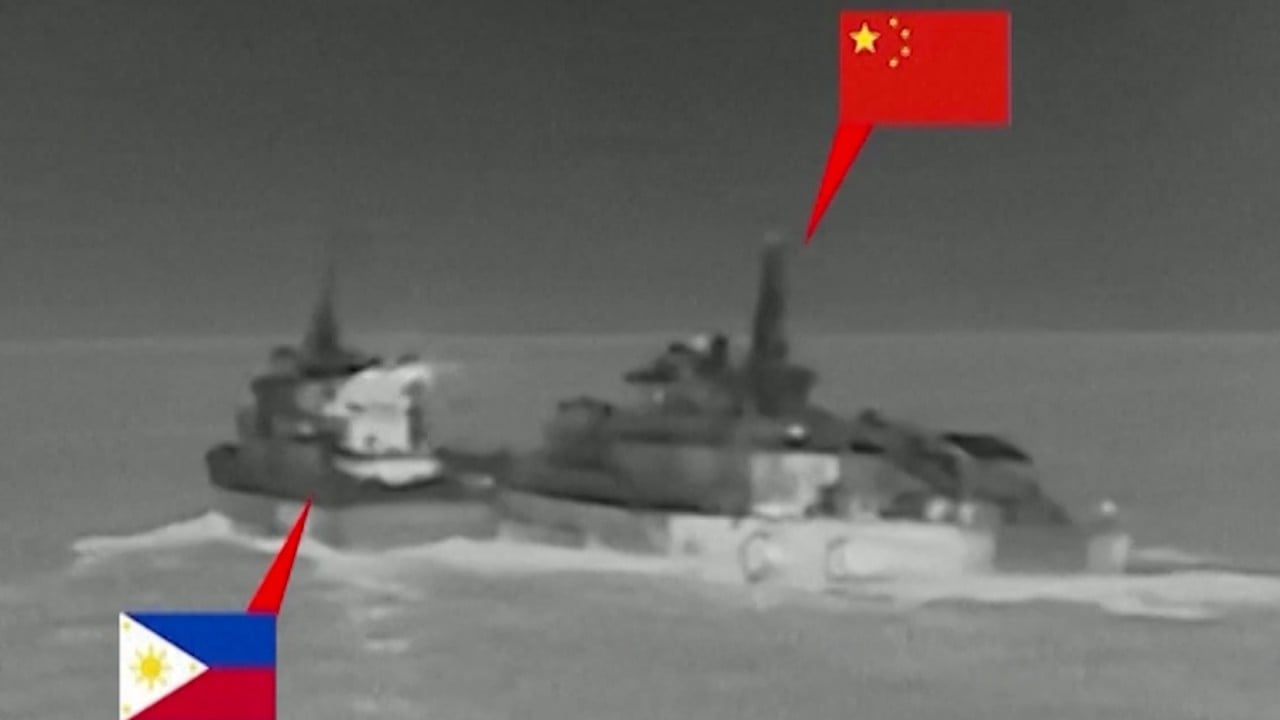The Philippine government on Monday slammed the “dangerous and illegal manoeuvres” of Chinese coastguard vessels that led to a collision with two Philippine coastguard vessels in Manila’s exclusive economic zone.
Analysts warn that the mild statement from the Philippines – issued by Jonathan Malaya, a spokesman for the multi-agency National Task Force on the West Philippine Sea (NTF-WPS) – could embolden China to carry out further provocations.
It has also raised concerns about whether the Philippines would seek stronger support from its allies or defuse tensions on its own over its long-standing maritime row with China.
The incident took place early on Monday morning near the disputed Sabina Shoal in the South China Sea.
In a statement, the Chinese coastguard (CCG) claimed the “deliberate” collision arose from the “unprofessional and dangerous” behaviour of the Philippine coastguard (PCG).
The CCG released two videos of the ramming incident on Monday near what Beijing referred to as Xianbin Jiao, its name for the Sabina Shoal.
The collision resulted in damage to two PCG vessels. No Filipino sailors were injured, according to media reports.

In response to China’s statements, Malaya criticised the CCG in a statement but stopped short of condemning Beijing over the incident.
Malaya urged China to observe “restraint and adherence to the United Nations Convention on the Law of the Sea (Unclos) and other relevant international laws to prevent further escalations and ensure the safety of all vessels operating in the region”.
The latest escalation in the dispute occurred 11 days after a Chinese air force plane fired a series of flares in the path of a Philippine air force plane.
In another incident two months ago, a Filipino navy man lost his thumb after the Chinese navy rammed a Philippine vessel. Chinese sailors boarded and vandalised several Philippine vessels while wielding spears and long knives, and seized firearms during the incident.
Malaya’s NTF-WPS statement also said two Philippine coastguard vessels were damaged in three collision incidents near the Escoda Shoal after being rammed by Chinese coastguard ships.
The Chinese state-owned Global Times, however, claimed that the incidents were provoked by the Philippine vessels, including one in which the BRP Bagacay allegedly rammed the Chinese ship CCGV 21551 at 3.24am despite repeated warnings.
Malaya’s NTF-WPS statement, however, rejects the Chinese Coast Guard’s version. It said, the second and third collisions happened at 3:40am, around 21.3 nautical miles southeast of Escoda Shoal, when BRP Bagacay (MRRV-4410) “was rammed twice on both her port and starboard sides by CCGV 21551, leading to minor structural damage.”
Nearly 90 per cent of the Philippines’ exclusive economic zone falls under what China claims is its maritime territory within its so-called nine-dash line. An arbitral tribunal in The Hague ruled in 2016 that China’s claim had no legal basis under Unclos, a ruling not recognised by Beijing.
Retired Philippine Supreme Court associate justice Antonio Carpio told This Week in Asia on Monday that the Philippines could file a case before an Unclos tribunal and demand damages over the latest incident.
Foreign Secretary Enrique Manalo told the Foreign Correspondents Association of the Philippines on August 16 that Manila was not in a hurry to demand any compensation. The government was “still studying” how much to demand from China for damages, he said.
Manalo also said the provisional agreement reached with China during the latest round of bilateral talks only covered the Philippines’ resupply missions to the Ayungin Shoal – Manila’s name for the Second Thomas Shoal – and excluded other contested features in the South China Sea.
He declined to describe the situation in the South China Sea as “a flashpoint” but said it was a challenge to deal with the simmering tensions.
Ray Powell, a maritime security analyst, told This Week in Asia that China had attempted to block the Philippine vessels because it believed they were going to the Sabina Shoal, which “provided the pretext for its aggressions” there.

Powell, a retired American air force colonel who heads Stanford University’s Sea Light project, told This Week in Asia: “Beijing’s propaganda has been telegraphing its intent to aggressively blockade the Sabina Shoal for much of the past week. For several months, it has been drawing parallels between the BRP Teresa Magbanua, the Philippine coastguard’s ship anchored there, and the grounded BRP Sierra Madre at the Second Thomas Shoal.”
By doing so, China has moved the frontlines of the maritime spat to within 75 nautical miles of the Philippine coastline, according to Powell.
“The Philippines will again be challenged to consider whether now is the time to look to its US ally for more direct support,” he added.
On Monday, US envoy to Manila MaryKay Carlson posted on ‘X” that Washington was in solidarity with Manila and condemned the incident. “We are committed to supporting the rights of our #FriendsPartnersAllies under international law.”
The Akbayan opposition party called China a “bully” in a statement, dismissing Beijing’s “absurd” claim that Filipino sailors were responsible for the incident.
The US had previously offered its help after the June 17 incident but the Philippine military turned it down.
Lucio Blanco Pitlo III, a research fellow at the Asia-Pacific Pathways to Progress think tank in Manila, told This Week in Asia that China was likely wary of Philippine vessels being in the Sabina Shoal area, similar to Beijing’s presence in the Scarborough Shoal. On the other hand, the Philippines was concerned that China could build structures on the Sabina Shoal just as Beijing did previously for the Mischief Reef, Pitlo said.
Pitlo, currently a visiting fellow at Taiwan’s Department of Diplomacy at National Chengchi University, said the Sabina Shoal was a strategic point for Manila’s resupply missions to the Second Thomas Shoal.
“Chinese control of Sabina may further isolate Ayungin Shoal [Second Thomas Shoal] and bring Beijing closer to the coast of Palawan. The reported presence of damaged or dead corals in Sabina stoked fears that China may do another fait accompli in the unoccupied reef.”



